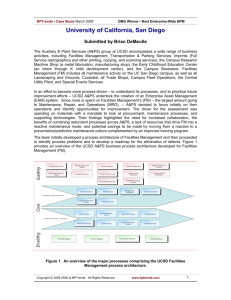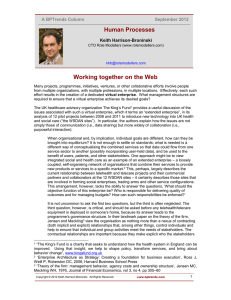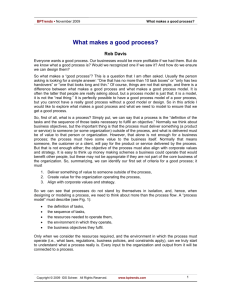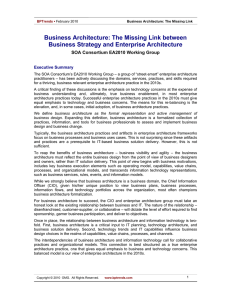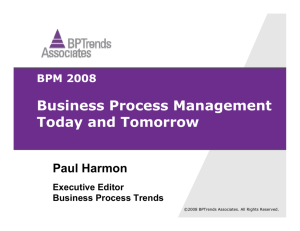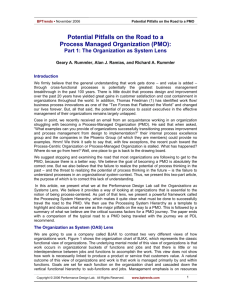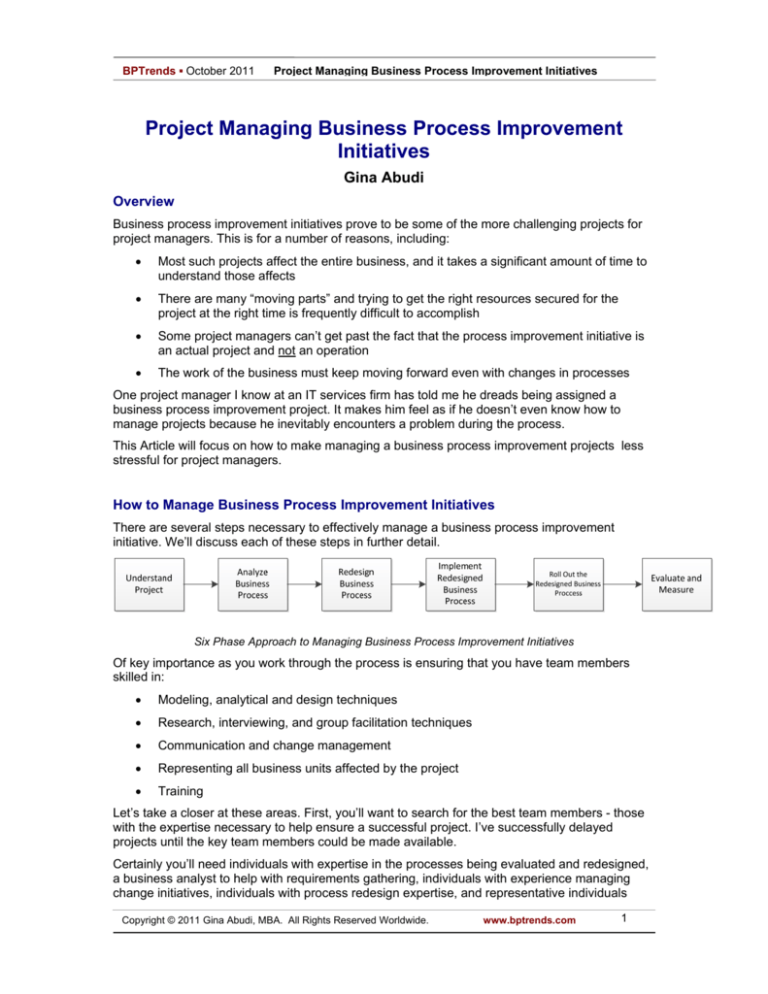
BPTrends ▪ October 2011
Project Managing Business Process Improvement Initiatives
Project Managing Business Process Improvement
Initiatives
Gina Abudi
Overview
Business process improvement initiatives prove to be some of the more challenging projects for
project managers. This is for a number of reasons, including:
•
Most such projects affect the entire business, and it takes a significant amount of time to
understand those affects
•
There are many “moving parts” and trying to get the right resources secured for the
project at the right time is frequently difficult to accomplish
•
Some project managers can’t get past the fact that the process improvement initiative is
an actual project and not an operation
•
The work of the business must keep moving forward even with changes in processes
One project manager I know at an IT services firm has told me he dreads being assigned a
business process improvement project. It makes him feel as if he doesn’t even know how to
manage projects because he inevitably encounters a problem during the process.
This Article will focus on how to make managing a business process improvement projects less
stressful for project managers.
How to Manage Business Process Improvement Initiatives
There are several steps necessary to effectively manage a business process improvement
initiative. We’ll discuss each of these steps in further detail.
Six Phase Approach to Managing Business Process Improvement Initiatives
Of key importance as you work through the process is ensuring that you have team members
skilled in:
•
Modeling, analytical and design techniques
•
Research, interviewing, and group facilitation techniques
•
Communication and change management
•
Representing all business units affected by the project
•
Training
Let’s take a closer at these areas. First, you’ll want to search for the best team members - those
with the expertise necessary to help ensure a successful project. I’ve successfully delayed
projects until the key team members could be made available.
Certainly you’ll need individuals with expertise in the processes being evaluated and redesigned,
a business analyst to help with requirements gathering, individuals with experience managing
change initiatives, individuals with process redesign expertise, and representative individuals
Copyright © 2011 Gina Abudi, MBA. All Rights Reserved Worldwide.
www.bptrends.com
1
BPTrends ▪ October 2011
Project Managing Business Process Improvement Initiatives
from every department or business unit being affected by the project. For the latter group, in
addition to management level staff, you will want to include those employees actually doing the
work from day-to-day because they will bring a perspective management simply doesn’t have.
Trainers are also needed to ensure that all employees affected by the change know how to utilize
the new processes.
Support Teams
Consider a process advisory team to support the project - individuals who represent the
perspective of a particular department or business unit being affected-- to be the pilot test group.
You can bounce ideas off of the team members to get their perspective on how a particular
process may help them to perform their tasks. While your advisory team will not be involved in the
project day-to-day, they will serve as your “test crew” and will help you promote the project within
the company.
Also consider establishing Checkpoint Review Teams to make recommendations on whether to
proceed with aspects of the project at your “go/no go” decision points. These team members
should be separate from your day-to-day team and will help with quality testing, communications,
risk identification and provide general guidance for you, the project manager.
Change Management
If you do not already have a change management framework in place, it is highly recommended
that you implement one prior to taking on a large business process improvement initiative.
Change management is a significant component of such initiatives. We are not talking about how
to handle changes that occur on the project, although that is certainly key as well! Rather, we are
talking about managing staff expectations around changes. Change is hard , and in order to
ensure success in business process improvement initiatives, you must have a plan in place to
educate, prepare, and enable staff to accept and embrace the changes that will affect their jobs.
Do not shortchange this process. Regular, honest and continuous communications are essential.
Never underestimate how much time you will need to “sell” the initiative to the organization. And
never forget that someone “on board” in the beginning could suddenly turn into a detractor. Keep
those being effected up to date on the project and its status and check in frequently with them to
be sure they are still feeling confident and comfortable with what is happening.
Several Skills Needed
The process above requires you to have more than just strong technical project management
skills. You’ll also need:
•
Facilitation skills
•
The ability to build strong working relationships
•
Affective communication and presentation skills
•
The ability to influence others
•
Team leadership skills
In fact, I’d suggest that more important than your technical project management skills are your
people skills. Your ability to make connections with others, gain their confidence and make them
comfortable with what is happening are essential components of a successful project.
The Six Phases of Managing Process Improvement Initiatives
Let’s look at the six phases identified above in more detail. But first, remember this - as project
manager, you must continuously monitor and control business process improvement projects.
Never shortchange the amount of time required to actually manage the project to ensure a
successful conclusion. Such initiatives are definitely not “hands off” projects and require your
constant attention to detail. But first…the project team kick-off meeting…
Copyright © 2011 Gina Abudi, MBA. All Rights Reserved Worldwide.
www.bptrends.com
2
BPTrends ▪ October 2011
Project Managing Business Process Improvement Initiatives
Project Team Kick-Off Meeting
Before the project even launches, hold a meeting with the entire project team. If the team is not
co-located, I’d highly recommend making the case to get the team together face-to-face for at
least a day. If possible, ask the project sponsor and other key stakeholders to participate. This
important project team kick-off meeting enables you to:
•
Communicate the importance of the initiative and its impact on the organization
•
Review project objectives and benefits to the organization
•
Answer questions and address concerns (remember - some of your project team
members may also be impacted by the coming changes!)
•
Set expectations for status reporting and regular communications
•
Enable the team members to become acquainted with each other, thus raising their
comfort level and confidence in working with each other
•
Work with the team to establish processes and procedures around:
o
Problem solving
o
Decision making
o
Escalation of problems
Phase 1: Understand the Project Need
In this initial phase of the project you are:
•
Developing an initial description of the problem to be solved
•
Developing your preliminary project plan, including key checkpoints for go/no go
decisions
•
Identifying your stakeholders
•
Identifying the full project team
•
Determining the preliminary project scope
•
Determining desired performance improvements in the business
•
Preparing the preliminary business case for the change in process
•
Developing the process vision statement (work with key executive stakeholders to
determine their vision of a “to be” process.)
•
Developing preliminary communication plans
•
Setting preliminary timelines and budgets
•
Determining training needs and implementation/roll out plans
This information is required for approval to move forward with the initiative. Don’t work in a
bubble; get your initially identified team members involved in this phase - they will have expertise
you don’t have and will bring a different perspective to the project.
Most particularly in this initial phase, project managers often find it challenging to identify who will
be effected by the project - frequently they forget some key stakeholders. Remember that your
stakeholders include everyone who will be impacted by the project in any way. There are direct
stakeholders and indirect stakeholders.
Copyright © 2011 Gina Abudi, MBA. All Rights Reserved Worldwide.
www.bptrends.com
3
BPTrends ▪ October 2011
Project Managing Business Process Improvement Initiatives
For example, let’s assume you are changing processes for how customer information is captured
into your Customer Relationship Management System. You likely have remembered to include
Sales and Marketing in your stakeholder list; but have you considered:
•
The actual customer - who will want to be aware of what information is being captured
and how it is being used
•
The receptionist and other administrative personnel - individuals who may have first
contact with the customer
As a best practice, just when you think you have identified all stakeholders - step back and
reconsider your list, and add anyone you may have missed.
Ideally in this early phase of the project you’ll want to have a few key team members in place:
•
Individuals with expertise in analysis and redesign of processes
•
Individuals who represent the department/business unit being effected
These individuals can help to ensure that you are getting all the necessary information to move to
the next step, i.e. approval to move forward with the project.
Be sure your business case includes, at a minimum, information on:
•
The initial problem statement
•
Process or processes that are part of the project scope
•
High level schedule
•
Initial resource requirements
•
Initial budget requirements
•
Potential project risks
•
Expected ROI
If you don’t fully understand the project and who will be impacted, you are unlikely to have a
successfully conclusion.
Phase 2: Analyze the Current Business Process
Once you have approval to move forward to Phase 2, update your project documents to reflect
any changes or additional information you have received.
This phase focuses on looking closely at the current process that is to be changed. Gather
information on the current (“as is”) process through a variety of ways, including:
•
Interviews
•
Focus groups
•
Surveys
•
Observation (of individuals working with the current process)
The “as is” model of the process will enable you to see where the gaps are and where
improvement opportunities exist. You’ll also determine the root cause of the problem.
Your team members in this phase include a process analyst, a process modeler, a facilitator for
focus group workshops and your process advisory team members.
Don’t hesitate in this phase to speak one-on-one with those using the current process specifically
to learn their ideas for how they might improve their job performance. I have found that individuals
who are using the process day-after-day frequently have ideas and suggestions on how to make
Copyright © 2011 Gina Abudi, MBA. All Rights Reserved Worldwide.
www.bptrends.com
4
BPTrends ▪ October 2011
Project Managing Business Process Improvement Initiatives
their job easier (and they may be using those methods already). Don’t assume this information
will come out during the formal interview process. Make a point to ask them specifically about it.
Once you have developed your “as is” process, validate it with those doing the job to be sure you
incorporated everything.
Once your data is gathered and you have developed and validated the “as is” process, present
your findings formally to the sponsor and key executive stakeholders for approval to move on to
the next phase of the project.
Phase 3: Redesign of the Business Process
In Phase 3 you will focus on best practice research and on developing a redesign of the business
process - your “could be” options.
Stakeholder input is absolutely essential at this point. Not just from the management/executive
level, but those individuals who are actually using the process or will need to do so. Anyone
impacted by the change should be involved in some way - whether they participate on teams
providing input in redesigning the process or are available to bounce ideas off of and test
theories. You and your team will be working quite extensively with the stakeholders throughout
Phase 3.
Take these steps:
•
Do some research
o
What are current best practices?
o
What are some innovative ideas in use by competitors?
•
Remember - competitive information often attracts the attention of
executives
What are the criteria for the new process? This will affect the “could be” options. E.g.,
o
Customer calls answered by the second ring
o
Data entered into a customer relationship system accurately 100% of the time
o
Packages delivered to the correct address 100% of the time
•
Determine relational importance of the criteria for the new process - prioritize based on
company needs
•
What are the “could be” options for the process?
o
•
Use brainstorming techniques to capture all possibilities then narrow down to 2 3 of the best options to test with stakeholders
Design “could be” processes based on the criteria
o
Will the “could be” process options enable the criteria to be met?
•
Socialize with all relevant stakeholders the 2 - 3 “could be” processes mapped out and
get feedback
•
Develop a “to be” option from the 2 - 3 “could be” options based on:
o
Which process best meets the needs
o
Which process gets the most “thumbs up” from stakeholders
o
Which process, when implemented, will meet all stakeholder needs and business
objectives
Copyright © 2011 Gina Abudi, MBA. All Rights Reserved Worldwide.
www.bptrends.com
5
BPTrends ▪ October 2011
o
Project Managing Business Process Improvement Initiatives
Think about requirements around technology, facilities, equipment and training
needs
You might, for example, take the best of all “could be” options to develop a final “to be” option for
presentation to the executive stakeholders.
A straw model development of the new process (“to be” option) is a great way for those
stakeholders effected to see how it might work for them. Get a small pilot group to try it out.
Presentation to Executives
When presenting your “to be” option for go/no go decision to the executive stakeholders, be sure
to be prepared to discuss:
•
Impact on technology, facilities, equipment
•
Training needs
•
Budget requirements
•
Benefits to the organization
•
Potential risks in implementation
Be prepared to present a detailed plan for implementation and roll out of the new process, along
with plans for evaluating its success and measuring it against the established criteria.
All of this should be included in your updated business case and updated project plan. Once
approval is obtained from the executive stakeholders, move to Phase 4.
Phase 4: Implement the Redesigned Process
Phase 4, implementing the redesigned process, includes finalizing the “to be” process your team
designed based on any feedback and final decisions from the executive stakeholders. Remember
that the current team members may not have the skills to assist in the implementation phase so
be sure to pull together the team that will oversee implementation. Again, some representative
group from those business units/departments affected should be included on the team.
Undoubtedly there are sub-projects involved - be sure to identify all of them. For example:
•
Human Resources to develop new roles and responsibilities or to provide training the
new process
•
Information Technology to secure new hardware and develop software
•
Operations to develop policies and procedures around the new process
The members of your process redesign team should be assigned in the sub-project teams so that
there is consistency and valuable information and insight is not lost.
Of key importance to you as the project manager, is to maintain regular meetings with all subproject team leads to ensure information sharing, problem resolution and continued control and
maintenance of the required timeline, budget and quality expectations. It is important that all subteams follow the same processes around documentation, status reporting, testing procedures,
etc.
In Phase 4 you are focused on keeping the sub-project teams working toward a common goal. I
have met with great success in using a collaboration portal to ensure coordination among all subteams and to keep all necessary data and information accessible by all team members and
stakeholders.
Copyright © 2011 Gina Abudi, MBA. All Rights Reserved Worldwide.
www.bptrends.com
6
BPTrends ▪ October 2011
Project Managing Business Process Improvement Initiatives
Pilot Group
A pilot group should run through the entire process from start to finish looking for any issues that
may arise. Do not underestimate the importance of proper and thorough testing of the new
process. This will be a large component of the time required to complete the project and is
essential to be done prior to full roll out and implementation of the process company-wide.
Make any changes or “tweaks” based on the pilot group’s testing results, retest, and prepare for
full roll out.
Presentation to the Executive Stakeholders
Your presentation to the executive stakeholders should focus on the finalized process, including
results of the testing done by the pilot group. Present your plan for full roll out company-wide
including:
•
Communications strategies
•
Training plan
•
Timeline for roll out
•
Plan for evaluation and measurement of impact on the business
Phase 5: Roll Out the Redesigned Process
In Phase 5, you may have yet another team in place for roll out. These team members may
include individuals to assist in training staff on the new processes and also being available to
answer questions and ensuring everyone utilizing the new process is confident and comfortable
in their abilities to perform their roles.
Be sure to spend time communicating throughout the organization (remember you should have
been communicating status all along to everyone) - the more people know, the more comfortable
and confident they feel, and - the more they have anticipated and bought into the future change..
Ask your pilot group to help communicate the new process to their colleagues. Having worked
with the new process, they can be invaluable champions. They can answer questions and
address the concerns of their peers who are less familiar with the new process. Use a variety of
methods to communicate:
•
Email
•
“Lunch and Learn” discussions
•
Company portal
•
Internal newsletter
•
Small group meetings
Be sure that training is provided to everyone who will be using the new process and that they feel
comfortable before they are sent off to use it. Ensure training programs include hands-on practice
time.
The more confident those affected by the change feel - they have been well trained, they
understand why the change is happening and the benefits that will accrue to the organization and
to them, they feel a part of the solution - the more likely you will have a successful roll out of a
new process within the organization.
Copyright © 2011 Gina Abudi, MBA. All Rights Reserved Worldwide.
www.bptrends.com
7
BPTrends ▪ October 2011
Project Managing Business Process Improvement Initiatives
Phase 6: Evaluate and Measure
A cross-functional continuous improvement team - comprised of individuals from all departments
effected - should be put in place to evaluate and monitor the new process and measure against
business impact criteria put in place by the executives.
Be sure a team is also available - a few “go to” people - for questions, concerns and comments
that arise as the process is used. Even though it has been tested, you may still find that some
small adjustments are required as it is being fully utilized within the organization.
Gather together all stakeholders and team members for a debriefing meeting to discuss what
went well on the project and where improvements are required for future projects. Capture these
lessons learned for use on future process improvement projects.
Summary
Of key importance in any process redesign project - regardless of its size or impact within the
organization - is not to underestimate the time needed to communicate beforehand and getting
potential champions on board with the change. Ensure a change management process is
followed throughout and affectively plan for, including any contingencies. There will be issues - be
prepared for them by developing a comprehensive project management plan for the initiative.
Taking a project management approach to business process improvement initiatives increases
the likelihood of success and adoption throughout the organization.
Adopt these best practices to ensure a successful process improvement project:
•
Develop a comprehensive project management plan including:
o
Change management plan
o
Communications plan
o
Risk management plan
o
Testing plan
o
Training plan
o
Roll out, measurement and evaluation plan
•
Continuous communication keeps everyone moving toward the same objective
•
Monitoring and controlling is essential as is having the right people on the project team
and the project sub-teams at the right time
•
Process improvement experts are essential on the team
•
Rely on employees from throughout the organization who will be impacted by the change
to help provide ideas, suggestions, test out theories and help you to socialize the initiative
While these are challenging initiatives for all project managers - even the most seasoned - the
better prepared you are for the project, the more likely you’ll have a successful conclusion.
______
Author
Gina Abudi, MBA, President of Abudi Consulting Group, LLC has 20+ years’ experience in project
and process management and management/leadership strategy, including strategic learning and
development programs, and business impact and ROI. She is co-author of The Complete Idiot’s
Guide to Best Practices for Small Business (Alpha Books, 2011) and President of the PMI®
Massachusetts Bay Chapter Board of Directors. Gina can be reached via her website:
http://www.AbudiConsulting.com.
Copyright © 2011 Gina Abudi, MBA. All Rights Reserved Worldwide.
www.bptrends.com
8
BPTrends ▪ October 2011
Project Managing Business Process Improvement Initiatives
BPTrends Linkedin Discussion Group
We recently created a BPTrends Discussion Group on Linkedin to allow our members, readers
and friends to freely exchange ideas on a wide variety of BPM related topics. We encourage you
to initiate a new discussion on this publication or on other BPM related topics of interest to you, or
to contribute to existing discussions. Go to Linkedin and join the BPTrends Discussion Group.
Copyright © 2011 Gina Abudi, MBA. All Rights Reserved Worldwide.
www.bptrends.com
9

